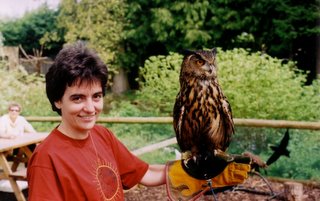 My Wife The Vet
My Wife The VetWhenever I tell people my wife is a veterinary surgeon, they seem impressed. Sometimes I wish to enlighten them further about her noble career, but I desist, many would not understand. This is not to say that I am not proud of her--far from it. I accompany her whenever she is on call; though it be a far cry from working with snakes and crocodiles in India, it is the closest I get to the animal kingdom out here in the Midlands, and dare I say, a Freisian cow thrashing about in a dimly lit shed can be a more formidable adversary than a cobra on a rooftop.
I now teach English as a second language at Telford College of Arts & Technology; I also keep house, a task I have embarked upon with alarming cheerfulness. Still, some things do rattle our makeshift routine, calls during dinner are one of them. How often have I rustled up a meal for the missus, only to abandon it when she has to dash off to a calving or a lambing. New Year’s eve was memorable, we had just sat down to a lovely dinner when the phone rang. T'was a calving. Of course the cow had to be a priceless Belgian blue, whose calves cost a small fortune, so that the farmer would only let it set foot upon the earth via a lengthy caesarean. I don’t blame him; Belgian blues have huge pelvises, very often the head of the calf makes it easily enough through the vulva, but then the pelvis refuses to come through, no matter how hard you keep yanking. By the time we finished this caesarean it was 3 am. We drove home wearily, after the farmer insisted on a small celebration. By 8 am there were more calls coming in.
Similar routine another night. Dinner ready, phone rings, call out to caesarean, back home late, gulp down cold dinner, stagger into bed when---the phone rings again. It could only be the answering service. Please don’t let it be another calving, I prayed. We have already done two caesareans in a night, and are not particularly interested in breaking that record…
Our luck holds, it isn’t a caesarean. The girl on the answering service says: “Mrs Hammond feels her hamster needs urgent attention.”

Mrs Hammond loved her hamster, with good reason; she thought nothing of asking for help at any time of the day or night on behalf of Edgar. It had been a great family companion for many years, a source of pure delight for her children-- a good twenty minutes had passed before Mrs Hammond paused in her tales about Edgar.
“Poor Edgar,”she concluded, “He is in such pain…I can’t bear to see him suffer. Can you put it to sleep? ”
My wife asked Mrs Hammond to please bring her hamster down to the surgery as soon as possible.
On examining the hamster, it was obvious that Mrs Hammond was right--the hamster was indeed very ill. But it was also obvious that its condition had steadily worsened over the last few days, not suddenly as Mrs Hammond had put it. Now thanks to sheer negligence its condition had deteriorated so much that the only humane solution was to put it to sleep. My wife duly conducted a PTS, after which we drove back home quickly.
The hamster was out of distress, but Mrs Hammond wasn’t. She called again, three weeks later. “Fifty pounds to put a hamster to sleep! This is shocking, I should have just let it die!”
Fifty pounds. We had a plumber come in the other day to repair our leaking cistern. “I’m not sure what the cause is, but I will have to open the tank,” he said when he strolled in hours later. “ It will cost you 55 quid. After that if I find that the cause is elsewhere, I will have to charge extra.” I nodded meekly. And this was not even a weekend!
“I should have just let it die!” A good ploy indeed, make your vet feel guilty. How can vets possibly think of charging people to put hamsters to sleep. What a scourge on a noble profession!
Late night again. This was a concerned citizen.
I think I just hit a badger.
Where is it..
Oh, it ran off into the bushes, dragging its leg. Can you do something about it?
What do you want me to do?
I don’t know.
Can you get it to the surgery.
No, it ran off. I am at home.
Nowadays many surgeries have decided that the best way to cope with these demands is to hire an ‘out of hours’ emergency service. The vets employed here only work nights, can give better service (at least in theory), and spend more time with you- and your pet. The location might not be convenient, but it is a step forward in efficiency. And of course, the emergency service will only charge what a plumber would demand to get called out on a weekend. Mrs Hammond will love it!









